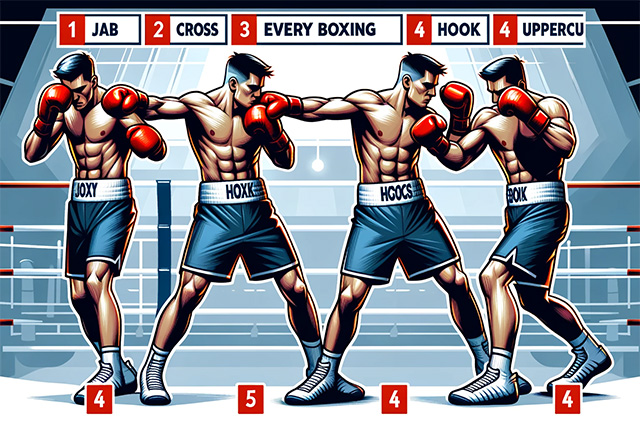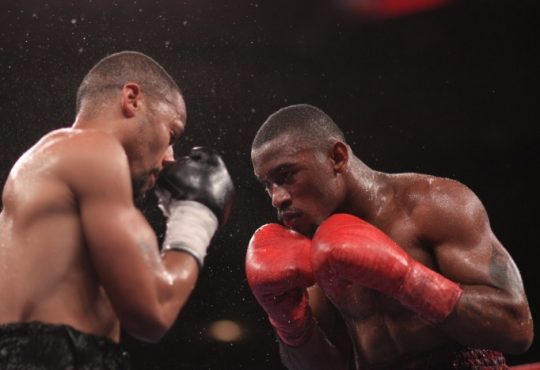
4 Essential Punches Every Boxer Must Know
You don’t need a dozen fancy moves to look sharp in the ring. Trust me, after two decades watching fighters rise and fall—both in gyms and underground circuits—it always comes back to the basics. I’ve seen guys with brutal speed fold under pressure simply because their jab was lazy. Or their rear hand floated outside their boxing guard like it was on vacation.
That’s why I always say: master the fundamentals first.
Not just to win fights, but to survive them. Sloppy form doesn’t just cost you points—it wrecks shoulders, snaps wrists, and opens up your chin like a welcome mat. I’ve wrapped enough busted knuckles to know.
Now, let’s talk about the core four.
The Jab: The Boxer’s GPS
You know what always stuck with me? The way old-school trainers talked about the jab like it was a religion. They didn’t say “throw it,” they said live behind it. Took me a few years to really get what that meant. The jab’s not flashy. It’s not what makes the highlight reel. But it runs the whole damn show—quietly, like a man who knows too much.
What I tell younger fighters is this: the jab tells you everything you need to know—distance, reaction time, rhythm. You put it out there, not to land big, but to feel. Feel where their head’s at, how far their lead foot is, how they twitch when you twitch. I’ve used it like a ruler, like a warning shot, like a decoy. Depends on the moment.
The cleanest ones come off a tight stance, shoulder tucked, elbow in, straight out and back—snap punch, not a push. And when it’s timed with a little front foot glide? That’s when it sticks. Like a needle. You’ll see their eyes blink more than once.
I’ve thrown thousands of jabs just to get one real opening. That’s the trade. You stay patient, read their rhythm, poke until they flinch—then you eat ’em alive. For me, it’s muscle memory now. Left hand pops without me thinking. That’s how it should be.
Most folks get bored with the jab. They want to brawl. They want fireworks. I’ll take control over chaos any day.

The Cross: The Power Engine
There’s something primal about landing a clean cross. Not flashy—just devastating. Over the years, I’ve watched countless fighters throw it wrong. Too much arm, too little body. You’ve probably seen it too—guys snapping their fist out like they’re flicking a jab. That’s not how the rear hand works when it’s meant to hurt.
You want real power? It starts at the ground. The rear foot torque, that twist through the hip, the tight core drive—that’s your engine. The hand is just the delivery system. What I learned early on (and yeah, the hard way) is that the pivot isn’t just a detail—it’s the fuse that lights the whole damn shot. Without it, you’re throwing a sentence with no period.
And timing? That’s the ghost in the machine. You don’t rush the cross. You let the weight shift, let the shoulder come through like a wave rolling out of your spine. When it’s right, you feel it—like you dropped the whole weight of your body behind the knuckles.
Here’s something folks don’t talk about enough: what happens after the punch lands. That punch follow-through, the way your feet and shoulders reset, how your chin stays tucked—that’s survival. You throw a lazy cross and hang there? You’re getting clipped on the return. Seen it more times than I can count.
The Knockout Curve: Mastering the Hook in Close Quarters
Here’s something they won’t teach you in your first week at the gym: the hook isn’t about muscle—it’s about geometry, torque, and guts. You don’t need to wind up or swing wild. You stay close, you keep it tight, and you let the hips do the talking. A proper lead hook snaps out like a coiled spring, short and nasty, while your head stays off-center—because you’re not just hitting, you’re avoiding the return fire.
Now, in close combat—those chest-to-chest exchanges where there’s no room for a jab—the hook is king. Lead hook to the chin. Rear hook to the liver. I’ve seen guys fold from a clean body hook that traveled maybe six inches. You don’t need range, you need rotation. The elbow comes up, the shoulder follows, and the shot lands flush before they realize they dropped their guard. I still remember a kid from Philly landing one inside the clinch—barely a whisper of motion—and his opponent didn’t get up until the stool came out.
What matters is delivery: compact, tight arc, elbow level, and no wasted movement. Let the shoulder snap, let the hips roll. The recoil should feel like a rubber band pulling you back into stance—ready to go again. That’s what separates a hook from a hopeful swing.
Timing the Uppercut: When to Let It Fly
Now, here’s the thing about the uppercut—it’s not just a punch, it’s a trap waiting to spring. You don’t toss it like a jab or spam it like a hook. It’s a reaction to a mistake, and your job is to notice that mistake a split second before your opponent even realizes they made one.
What I’ve learned in real close quarters—gym wars, smokers, even backroom bouts where nobody’s keeping score—is that the uppercut lives inside. It’s the inside man. Once your opponent dips forward, tight guard squeezing their temples like they’re bracing for a storm, that’s your shot. Their chin? Practically hanging over your glove.
You’ve gotta stay low—bend your knees, keep your weight under you. No wind-up. The power comes from the floor. From your calves to your hips, through your core, like snapping a heavy spring. A good uppercut doesn’t travel far—it rips straight up through a tight vertical arc. Short, brutal, and clean.
I see guys load up or lean back while throwing it, and that’s where the danger creeps in. You throw it long, you miss, and suddenly there’s a cross waiting to tattoo your cheekbone. That’s not theoretical—I’ve tasted that mistake. More than once.
So, watch their posture. Keep your inside leverage. And when you spot that moment—chin low, weight forward, guard sealed—don’t hesitate. Split the defense and let that uppercut climb straight through the middle. It’s not flashy. It’s not pretty. But it works, and when it lands, it’s the kind of punch they feel in their spine.
Flow and Fight IQ: How the Four Punches Connect in Combos
You know, after two decades in the game, one thing’s crystal clear: the magic doesn’t lie in any single punch—it’s in how you string them together. Jab, cross, hook, uppercut—they’re like the notes of a melody. Played right, they don’t just land; they guide the rhythm of the fight.
Now, most beginners think combos are fixed patterns—like a 1-2-hook, then repeat. But that’s predictable, and predictable gets punished. The real art is in layering: mixing punches to break your opponent’s rhythm and reset the tempo on your terms. For example, tossing a jab not to hit, but to blind. Then sliding in a rear uppercut when they guard tight. That’s not random—it’s calculated disruption.
What I’ve found most effective is changing the tempo mid-sequence. Maybe you start with a snappy jab-cross, pause half a beat, then rip a lead hook upstairs. That half-second hesitation? That’s the rhythm shift that freezes reactions. You’re not just throwing—you’re reading. Feeling. Setting traps.
Combo boxing drills help, but you’ve gotta move beyond memorized patterns. Make the jab a question. Let the uppercut be the answer they didn’t see coming. Vary your sequences—hook-cross-jab, or cross-uppercut-hook—to stay unreadable. The fighters who can do this aren’t just punching—they’re thinking three moves ahead. And that’s where real fight IQ lives.
Punch and Protect: Staying Safe While Staying Offensive
I’ve seen it too many times—fighters who throw sharp punches but leave their chin hanging like bait in open water. Look, throwing punches isn’t dangerous. It’s what happens after that gets you clipped. You don’t just attack in boxing—you calculate risk with every strike, then cover the gap on the way back. That’s where punch recovery, hand retraction, and defensive rhythm come into play.
Every time I throw a punch—whether it’s a jab to bait or a rear hand to counter—I’m already thinking about the return. That’s not paranoia, it’s timing. Hand comes out, hand comes back. It’s that simple. You’ve got to train your recovery to be as fast and natural as your delivery. I used to count beats in my head—1 for the punch, 2 for the guard return. It kept my rhythm sharp and my guard tighter than a vault.
What I’ve found especially useful is blending the offense with subtle defensive motion. For example, on the exit of a lead hook, I roll under automatically. On the end of a 1-2, I might slip right without even thinking. That kind of muscle memory is built off reps—years of it. You’re not just moving to look slick; you’re taking your head off the centerline and loading your next shot. That’s the secret sauce behind reactive timing and defensive boxing that doesn’t look like you’re playing defense.
And let’s talk about feints—because feints aren’t fluff. They’re functional. A lazy jab? Could be a setup. A paused shoulder roll? Could bait their right. I like using half-commits just to read reactions. Throw something they think is real, then read what they give you. That’s how you set traps without walking into one.
Bag Drills to Build Punch Timing and Intent
You want to talk about real punch training? Get to the heavy bag. Not just tapping it to look busy — I’m talking about using it to build real rhythm, torque, and timing. That bag’s not gonna lie to you. You throw lazy, it swings all over the place. You punch sharp, it absorbs like a body. That’s how you know.
What’s worked over the years — and I mean in actual gyms, not in some influencer garage setup — is starting with single-punch bag drills: 50 jabs, 50 crosses. Controlled pace, hands up between every shot. That repetition creates muscle imprinting without overthinking it. It’s not about going fast. It’s about going right. The moment you break form, reset. Get back in pocket.
Then, and only then, work short combinations: jab-cross-slip-cross. Or hook-cross-roll-hook. Bag training has this way of exposing sloppy mechanics. You throw a hook without your feet planted, you’ll feel it instantly — either in your shoulder or the way the bag wobbles instead of snapping. That’s feedback, raw and unfiltered.
Now, here’s a coaching cue I give young fighters: “Don’t just hit the bag — tell it something.” Meaning, every shot needs intent. Whether you’re doubling the jab to control space or sitting down on the rear hand, the message has to be clear. Sloppy shots don’t translate in the ring. But clean, repeatable ones? Those get remembered by your body when it counts.
What I’ve found is that over time, bag drills done with real focus build more than just power — they build accountability in your technique. And honestly, that’s what separates the guy who trains for social media from the one who’s ready to throw down after the fourth round.
Mistakes to Avoid When Throwing the Cross
You want power from your cross? Then start with balance. I’ve seen far too many fighters—especially newer ones—lean too far forward, thinking they’ll get more behind the shot. What actually happens? They end up off-balance, open, and stuck in place. You throw a cross to land and return—not to fall into your opponent’s counter.
Another common slip-up is over-rotating the rear foot or hips. I get it—you’re told to turn the hips, generate torque, etc. But there’s a difference between rotation and overcommitment. Once that rear shoulder flies too far across your centerline, it’s hard to recover. Your spine’s twisted, your chin’s floating, and that return hand? Usually nowhere near your face.
Now, about telegraphing—this one gets overlooked. Dropping the rear shoulder or tightening up right before release is like sending your opponent an engraved invitation. The moment they see the cue, they’re already prepping a counter or rolling under. I still catch myself doing this when I’m too tense, especially in sparring.
What’s worked for me is filming pad rounds and slowing the footage to 0.5x. You start to see things you’d never notice mid-round—sloppy form, dropped guard, even micro-hesitations. The fix isn’t always throwing harder. Sometimes it’s throwing smarter: controlled mechanics, sharp return, and never letting your cross compromise your stance. That’s how it becomes a weapon—not a liability.




